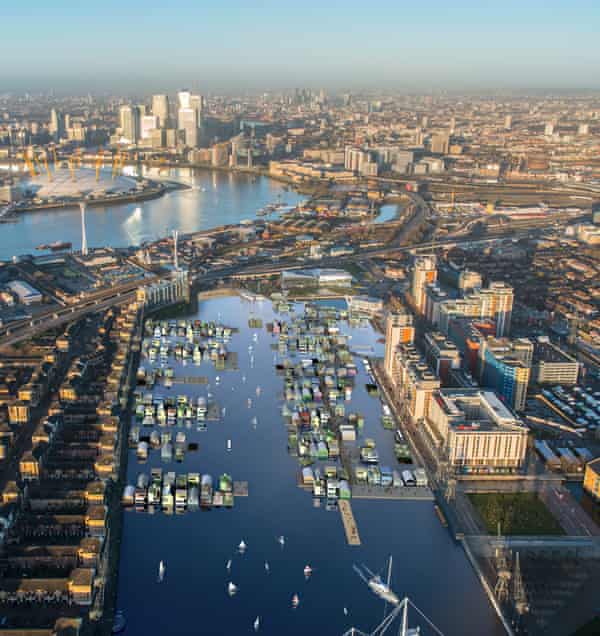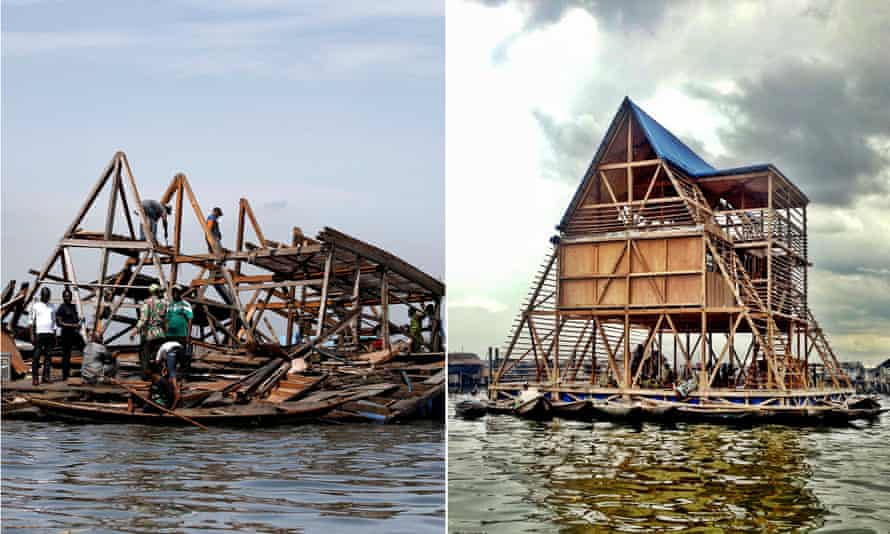City of Atlanta Green Infrastructure Manual Single Family Home
I t's a timber-clad house with open-programme living, pale floorboards and large windows giving views across Chichester culvert. This building designed by London-based Baca Architects has a unique feature – it floats.
Completed this month, the amphibious business firm was adult as a epitome past Baca and Floating Homes, a manufacturer specialising in flood-resilient housing, in response to a contest launched final twelvemonth to detect a solution to London's housing crisis.
The house is intended to be practical, affordable (a 2-bed unit volition sell for £200,000) and equipped to deal with floods, past rising with the water levels. Ultimately the visitor wants to unlock redundant waterways by building on "bluespace" sites – manmade docks, canals and marinas – beyond London.
"Collectively, bluespace has the potential to evangelize equally many as seven,500 floating homes with minimal disruption to existing communities", says Richard Coutts, director at Baca Architects.
Floating architecture has real potential to help ease some of London's housing issues, says Alex De Rijke of dRMM architects, which won a contest to pattern the Great britain'southward showtime floating villages in London Docklands.
"Architecture can only respond to overpopulation past addressing the questions of density, economy and speed of structure," says de Rijke, "The infinite of big rivers in urban areas tin can offering answers to these questions."

Architects and urban center planners across the world are starting to look beyond the traditional confines of the city, towards building on water as one of the answers to reducing inner-city population density and likewise developing flood-resilient designs. Global damage to cities from flooding could amount to $1tn a yr by 2050 if no action is taken, co-ordinate to a World Depository financial institution report.
Floating compages is nada new. Traditional floating villages are common in deltas and along the Mekong river in south-east asia. Simply integrating age-old designs into a mod metropolis is a different matter entirely.
Some cities are further alee than others. IJBurg is a collection of floating houses built on half-dozen artificial islands on IJ Lake in Amsterdam, designed by Marlies Rohmer. It was conceived to deal with the city's critical housing shortage problem equally well as its vulnerability to flooding – more than than half of the netherlands is at or beneath sea level.
The housing is a mix of expensive waterside condos and social housing, with virtually thirty% of the community's xviii,000 houses allocated to depression-income residents. When consummate, the development will provide homes for 45,000 residents on 10 islands.
In Copenhagen, architecture firm Urban Rigger has unveiled floating student housing made from end of life aircraft containers. Each Urban Rigger has 12 studio apartments which share a courtyard complete with a BBQ area, wheel racks and a kayak landing, and is powered in part by solar energy.
Tethered to docks in the city, the kickoff students are due to move at the end of the yr and will pay around £500-£600 a month. Over the adjacent decade, the company plans to build one,000-1,500 containers in "harbour, canal and river intensive cities" across Europe, says founder Kim Loudrup.

It's about "using infrastructure that's not being used for anything apart from looking nice", says Loudrop, who admits floating housing is "only function of the puzzle" when it comes to solving urban center housing crises. The beauty is, he says, that this kind of housing "tin can be initialised and utilised immediately; it comes in, stays for a period of time and and then tin move away again."
Building on h2o isn't straightforward, however. The recent plummet of the Makoko Floating School in Lagos, 1 of the nearly famous examples of floating architecture, shows some of the complexities.
The laurels-winning lagoon construction designed by Nigerian architect Kunlé Adeyemi of Dutch studio NLÉ Works was built to provide a school and community centre to a floating slum in the city but complanate in June after heavy rainfall.

Adeyemi says that the edifice had been decommissioned for months and was only intended as a prototype. But it led to a row as a local headmaster, Noah Shemede, raised concerns near the viability of the structure.
There are also environmental concerns. The need for foundations of many floating buildings to go deep into the river bed, for instance, will have an impact on the environment, says Phillip Mills, manager of the Policy Consulting Network, and a specialist in water structure.
"Foundations or structures inside the river could also alter the river bed with silt erosion and deposition elsewhere in the river. The same affair already happens around span piers," he says.
Edifice floating structures can also severely alter the catamenia of a river such as the Thames and disrupt ship, a spokesperson from the Port of London Authority explains. "What might conform belongings owners or private developers all-time is non ever best for the city. Londoners have said they want to run into the Thames used predominantly for transport or leisure. Any structures in the Thames could bear upon the catamenia of the river and create obstacles for watercraft."
However, Lucy Bullivant, adjunct professor of history and theory of urban design at Syracuse University, thinks there are greater environmental consequences building on land – such equally the trend to be more car focused – than on rivers. "Floating designs volition create a good anchor point for plants to help foster biodiversity and create habitats for fish and birds."
Building on bluefield sights can exist environmentally friendly, according to Mark Junak, director of Floating Homes. He says floating structures such equally those at Noorderhaven in holland have recently been bailiwick to underwater drone surveys to notice whether their construction has negatively affected the ecosystem.
Co-ordinate to the research projection, the underwater footage "revealed the existence of a dynamic and diverse aquatic habitat in the vicinity of these structures, showing that floating structures tin have a positive effect on the aquatic environment".
For London architect Carl Turner, who has designed a pre-fabricated, open up-source amphibious firm specifically designed to float on floodwater, called the Floating House, climate change means needing to piece of work with h2o.
"You either protect the house or protect the land," he says. "Creating large-scale overflowing protection zones is expensive and in itself potentially harmful to the environs. Once breached, homes are left defenceless, as opposed to floating homes that can simply rise with alluvion waters."
Source: https://www.theguardian.com/sustainable-business/2016/oct/29/floating-homes-architecture-build-water-overcrowding-cities-unaffordable-housing
Post a Comment for "City of Atlanta Green Infrastructure Manual Single Family Home"